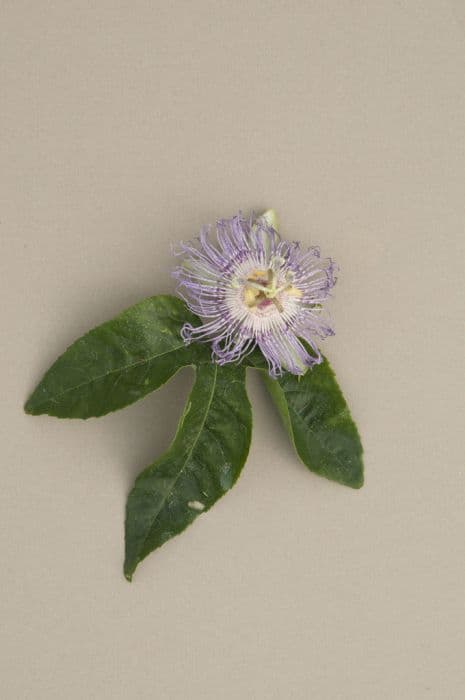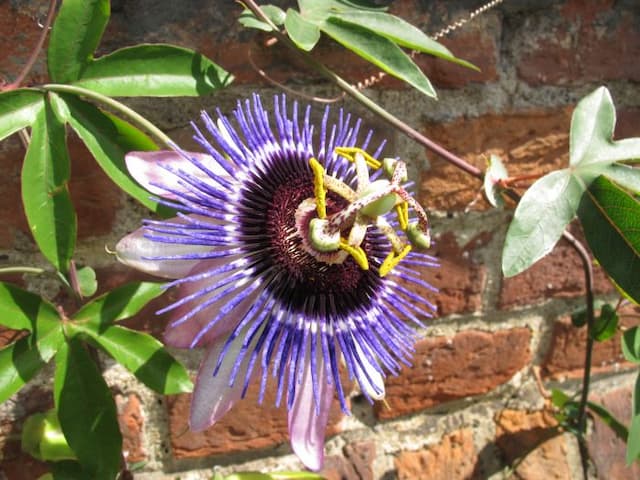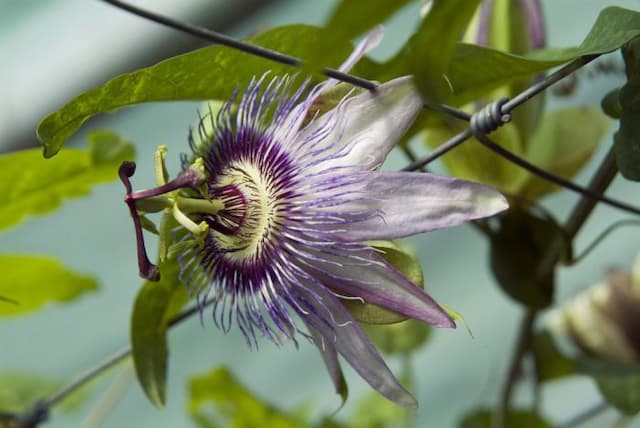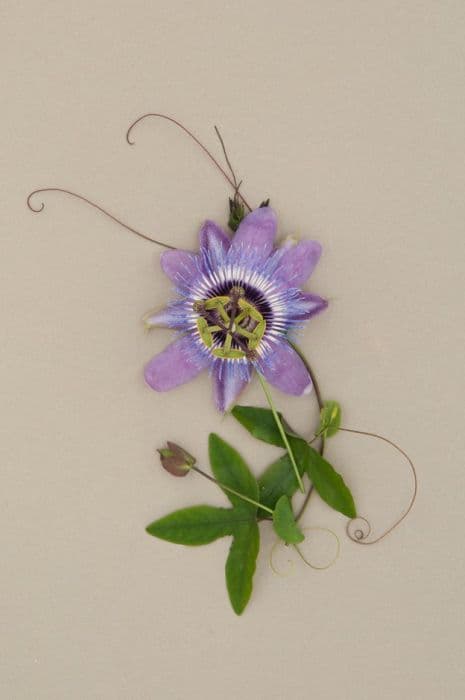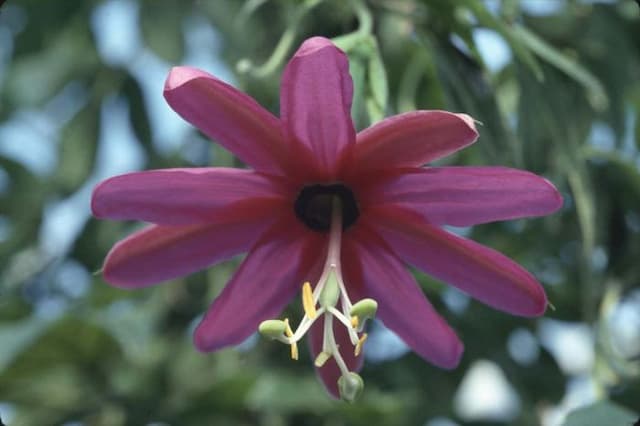Giant granadilla Passiflora quadrangularis (F)

ABOUT
Passiflora quadrangularis, commonly known as giant granadilla, is a fast-growing vine known for its large and intricate flowers as well as its sizable, edible fruit. The plant has lush, broad leaves that are heart-shaped and sometimes exhibit a deep green hue with three distinct lobes. Each leaf generally has a serrated edge and is attached to lengthy vines by a thin stem. The giant granadilla produces striking flowers that are highly ornamental. The blooms are aromatic and feature a range of colors, typically displaying white and purple hues. They have several layers of filaments surrounding a central structure, which adds to their complexity and ornate appearance. The fruit borne by this vine is one of the largest in its genus. It is oblong, typically developing a thick, hard rind that may appear in shades of green to yellow when ripe. Inside, the fruit contains a soft, sweet, and fragrant flesh filled with small, black edible seeds that are surrounded by a gelatinous pulp. The vines bear tendrils, which allows them to climb and support themselves on various structures or other plants. Owing to these tendrils, the giant granadilla looks quite spectacular as it drapes over trellises or fences, presenting both its decorative flowers and its sizeable fruit.
About this plant
 Names
NamesFamily
Passifloraceae
Synonyms
Giant Granadilla, Barbadine, Badea, Giant Tumbo, Grenadine, Giant Passion Fruit
Common names
Passiflora macrocarpa, Passiflora tetraden, Granadilla quadrangularis.
 Toxicity
ToxicityTo humans
The Passiflora quadrangularis, commonly known as giant granadilla, is not considered to be toxic to humans. In fact, the fruit of the giant granadilla is edible and often consumed. However, as with many plants, other parts of this plant, like the leaves and stems, are not typically consumed, and there can be a risk of gastrointestinal discomfort or other reactions in some individuals if these non-fruit parts of the plant are ingested in large amounts. To date, there is no widely recognized evidence of serious toxicity to humans from Passiflora quadrangularis.
To pets
Passiflora quadrangularis, known as giant granadilla, is not commonly listed among plants that are toxic to pets; however, it is always best to prevent pets from consuming plants not intended as food. Non-fruit parts of the plant, such as leaves and stems, may potentially cause mild gastrointestinal upset in pets if ingested in significant quantities. There is no significant evidence of severe poisoning from this plant in pets, but as with any non-food item, consumption should be avoided to prevent possible complications.
 Characteristics
CharacteristicsLife cycle
Perennials
Foliage type
Evergreen
Color of leaves
Green
Flower color
Mixed
Height
15-20 feet (4.6-6 meters)
Spread
6-8 feet (1.8-2.4 meters)
Plant type
Climber
Hardiness zones
10
Native area
South America
Benefits
 General Benefits
General Benefits- Edible Fruit: The passiflora quadrangularis, commonly known as Giant Granadilla, produces large, edible fruits that can be eaten fresh or used in juices, desserts, and other culinary preparations.
- Ornamental Plant: With its large, attractive flowers and vigorous vines, the Giant Granadilla serves as a beautiful ornamental plant, enhancing garden aesthetics.
- Pollinator Attraction: The showy flowers of the plant attract bees, butterflies, and other pollinators, benefiting the garden ecosystem.
- Shade Provider: The dense foliage of the Giant Granadilla vine can create shaded areas in gardens, offering a cool retreat during hot weather.
- Privacy Screen: Because of its fast-growing, dense vines, the Giant Granadilla can be used to create living privacy screens or to cover unsightly areas.
- Culinary Variety: The fruit brings a tropical flavor to a variety of dishes, expanding the diversity of a gastronomic palette with its unique taste.
- Cultural Significance: The Giant Granadilla holds cultural importance in various regions where it is grown, often used in traditional dishes and celebrations.
- Natural Fencing: The robust nature of the vine makes it suitable for use as a natural, living fence that can provide property boundaries in an eco-friendly way.
- Horticultural Interest: The plant's unique features, such as its square stems and large fruit, make it an object of interest for horticulturists and plant enthusiasts.
- Wildlife Habitat: The dense vines can serve as a habitat for various small wildlife species, encouraging biodiversity in a garden setting.
 Medical Properties
Medical Properties- Anxiolytic effects: Passiflora quadrangularis, commonly known as giant granadilla, has been used historically to help alleviate anxiety.
- Sedative properties: Traditional use suggests it may help in inducing sleep or calming the nervous system.
- Analgesic effects: Some people use extracts of this plant for its pain-relieving potential.
- Anti-inflammatory properties: There is historical use of Passiflora quadrangularis for reducing inflammation.
- Antispasmodic activity: Traditionally, it has been used to relieve muscle spasms and cramps.
 Air-purifying Qualities
Air-purifying QualitiesThis plant is not specifically known for air purifying qualities.
 Other Uses
Other Uses- Passiflora quadrangularis, commonly known as giant granadilla, has vines that can be used to create natural weavings or craft materials for items such as baskets and mats due to their length and flexibility.
- The large leaves of giant granadilla can serve as natural wraps for cooking, similar to banana leaves, and can infuse a subtle flavor into steamed dishes.
- The fruit pulp of giant granadilla can be used as a natural dye for textiles, offering shades of purple and magenta depending on the concentration and treatment of the fabric.
- Giant granadilla's smooth bark can be utilized in traditional craft-making for decorative purposes or as a natural paper in certain indigenous cultures.
- The sturdy tendrils of the plant can be fashioned into trellising for other plants in gardens, supporting the growth of climbing vegetables and flowers.
- The hollowed fruit shells of giant granadilla, once dried, can be used as containers for spices or small objects, or even crafted into musical instruments.
- The mild sedative properties found in the leaves of giant granadilla can be used to create a calming tea that promotes relaxation and alleviates stress.
- The fragrant flowers of giant granadilla can be incorporated into potpourri or used as a natural air freshener when dried and placed in cloth sachets.
- Decomposing parts of the giant granadilla plants such as leaves and fruits can serve as a nutrient-rich addition to compost piles, enriching the resulting soil amendment for gardening.
- Giant granadilla vines can create privacy screens or living fences when grown along trellises or mesh supports, enhancing garden aesthetics and providing habitat for beneficial insects.
Interesting Facts
 Feng Shui
Feng ShuiThe Giant Granadilla is not used in Feng Shui practice.
 Zodiac Sign Compitability
Zodiac Sign CompitabilityThe Giant Granadilla is not used in astrology practice.
 Plant Symbolism
Plant Symbolism- Passion: Passiflora quadrangularis, commonly known as Giant Granadilla, is symbolic of passion due to its name "Passion Flower" which refers to the Passion of Christ in Christian symbolism. Each part of the flower holds symbolic meaning concerning the crucifixion.
- Suffering and Sacrifice: The various components of the Passiflora flower represent different aspects of the crucifixion, such as the ten petals and sepals representing the ten faithful apostles (excluding Judas and Peter). Thus, it symbolizes suffering and sacrifice.
- Heavenly Love: The unique coronal filaments of the Giant Granadilla are often associated with the crown of thorns, symbolizing the unwavering love and sacrifice of Jesus, which translates into a broader representation of celestial or divine love.
- Faith: The clinging nature of the vine and the way it grows, seeking light, correlates to faith -- a reminder to maintain beliefs and to trust in a higher power.
- Mystical Awareness: With its exotic appearance and complex structure, the Giant Granadilla can symbolize an unlocking of mysteries and an invitation to deeper understanding or spiritual awakening.
 Water
WaterThe Giant Granadilla, which is the common name for Passiflora quadrangularis, requires consistent moisture and should be watered when the top inch of the soil feels dry to the touch. In general, this could mean watering approximately once a week, but the frequency depends on the environmental conditions, such as temperature and humidity. Each watering session should thoroughly soak the soil, using around 1 to 1.5 gallons of water, ensuring that the water reaches the root zone without leaving the plant in standing water.
 Light
LightGiant Granadilla thrives under full sun to partial shade conditions, preferring a bright spot that receives several hours of sunlight each day. Ideally, this plant should be positioned where it can enjoy morning sunlight and some shade during the hottest part of the afternoon, especially in very warm climates.
 Temperature
TemperatureThe Giant Granadilla prefers warm temperatures, with an ideal range between 68 to 86 degrees Fahrenheit. It can survive minimum temperatures down to around 50 degrees Fahrenheit but should be protected from frost. The plant will flourish if the temperature is consistently warm without drastic fluctuations.
 Pruning
PruningThe Giant Granadilla benefits from pruning to encourage healthy growth, remove dead or diseased material, and manage its size. Prune in early spring before the growing season begins. Cut back the vines to maintain the desired shape and size, and remove any weak or dead growth. Pruning can be done annually or as necessary to maintain the plant's health and appearance.
 Cleaning
CleaningAs needed
 Soil
SoilFor giant granadilla, a well-draining, rich soil mix is ideal with a pH between 6.5 and 7.5. Incorporate sphagnum peat, compost, and perlite or vermiculite in equal parts to provide the needed nutrients and aeration.
 Repotting
RepottingGiant granadilla should be repotted every 2-3 years or when roots become crowded. It's best done in spring to accommodate the plant's rapid growth during the growing season.
 Humidity & Misting
Humidity & MistingGiant granadilla thrives at humidity levels of 50-70%. If the air is too dry, mist the leaves regularly or use a humidifier to maintain optimal moisture.
 Suitable locations
Suitable locationsIndoor
Place giant granadilla in a bright spot and ensure high humidity.
Outdoor
Plant in full sun to partial shade and shelter from high winds.
Hardiness zone
10-11 USDA
 Life cycle
Life cyclePassiflora quadrangularis, commonly known as giant granadilla, begins its life cycle as a seed, which, when planted in fertile soil and given the right conditions, germinates and sprouts into a seedling. The seedling then grows into a vigorous, perennial vine with large, green leaves and tendrils that allow it to climb. Following a period of vegetative growth, the vine produces unique, aromatic flowers that mature into large, square-stemmed fruits containing numerous seeds. As a tropical plant, it typically flowers and fruits when conditions are warm and moist, usually year-round in suitable climates. After fruiting, the plant continues to live and can produce flowers and fruits multiple times. Eventually, as it reaches the end of its lifespan, which can vary depending on environmental factors, the vine dies back, releasing its seeds to start a new generation.
 Propogation
PropogationPropogation time
Spring-Summer
Passiflora quadrangularis, commonly known as giant granadilla, is best propagated using stem cuttings. This method is typically performed in late spring or early summer when the plant is actively growing. Stem cuttings should be taken from healthy, non-flowering shoots, ideally about 6 to 8 inches (15 to 20 centimeters) in length. The lower leaves of the cutting should be removed and the cut end dipped in rooting hormone to encourage root development. The prepared cutting is then inserted into a well-draining potting mix and kept humid by covering the pot with a plastic bag or placing it in a propagator. It is important to maintain a consistent temperature of about 75°F (24°C) and ensure the cuttings receive bright, indirect sunlight while they root, which usually takes between 3 to 4 weeks. Once rooted, the new plants can be gradually acclimated to the ambient environment before being potted on or planted out.

